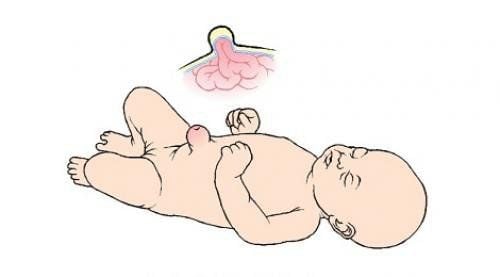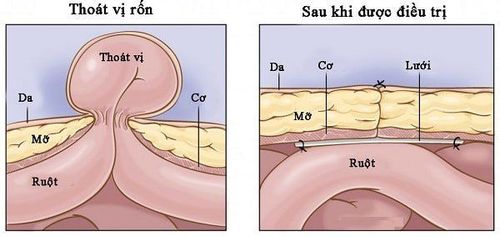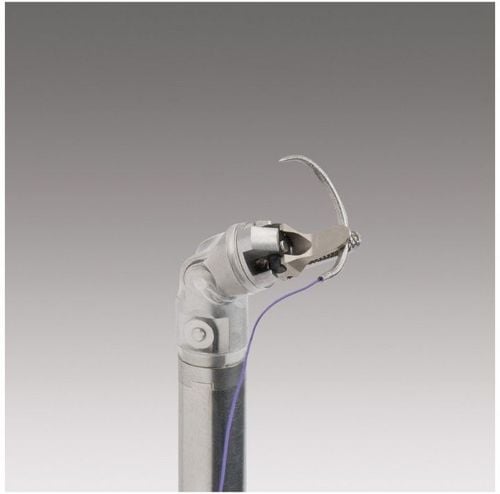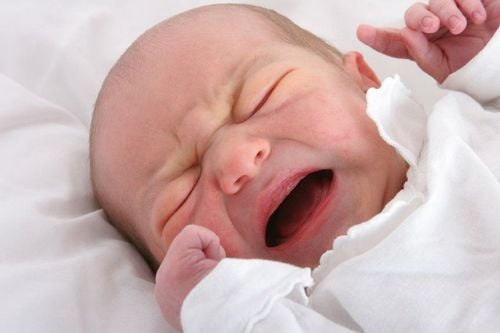This is an automatically translated article.
The article was professionally consulted by Associate Professor, Doctor, Doctor Huynh Thoai Loan - Head of Pediatrics - Neonatology Department, Vinmec Central Park International General Hospital.Many young children have a bulge in the navel, the bulge changes in size with activity. This is a sign of an umbilical hernia, a common birth defect in babies. So is this malformation dangerous and necessarily need surgery?
1. What is an umbilical hernia in an infant?
A hernia occurs when an organ or part of an organ protrudes out of its normal position in the body. Umbilical hernia occurs when internal organs in the abdomen bulge out, forming a protrusion in the navel area. The hernia may contain fluid, a portion of internal organs such as the intestines, or other organs from the abdomen.Umbilical hernias occur most often in babies born prematurely or with low birth weight. Up to 75% of infants weighing less than 1.5 kg have an umbilical hernia. This defect occurs more often in girls. Most umbilical hernias clear up on their own by age 1, although others take longer. About 90% of umbilical hernias will eventually close on their own. However, when a child is 4 years old and does not close on its own, surgery may be needed.

2. Causes of umbilical hernia in babies?
Babies are nourished in the womb by the umbilical cord. During pregnancy, the umbilical cord passes through a small hole in the baby's abdominal muscles and is cut when the baby is born. Within 1-2 weeks after birth, the umbilical cord will gradually shrink and fall off, the wound will heal and form the baby's navel, the hole in the abdominal wall where the umbilical cord passes will gradually close naturally as the baby grows. If the muscles do not close together completely in the midline of the abdomen, this weakness in the abdominal wall can cause an umbilical hernia or later in life.Trắc nghiệm: Thế nào là trẻ sơ sinh đủ tháng?
Đặc điểm bên ngoài của trẻ sơ sinh đủ tháng được thể hiện qua các tiêu chuẩn như: Cân nặng, chiều dài và hình thể. Theo dõi bài trắc nghiệm dưới đây sẽ giúp các bậc cha mẹ hiểu thế nào là trẻ sơ sinh đủ tháng, qua đó có thể đánh giá tổng trạng sức khỏe và sự phát triển của bé yêu nhà mình.The following content is prepared under supervision of Thạc sĩ, Bác sĩ y khoa, Ma Văn Thấm , Nhi , Phòng khám Đa khoa Quốc tế Vinmec Dương Đông(Phú Quốc)
3. Signs of umbilical hernia in infants
Signs of umbilical hernia in newborns are easy to recognize, just by observing the baby's navel position carefully, they can recognize the signs:In the baby's navel position, there will be a soft tumor protruding. . Every time your baby coughs, cries or arches, you can see a bulge. The bulge disappears when the baby is relaxed or lying on his back. Umbilical hernias are usually painless and do not cause any discomfort. If you suspect that your baby has an umbilical hernia, take your child to the doctor immediately if the following symptoms suddenly appear:
The baby cries harshly, or appears to be in pain. The abdomen appears larger, rounder, and fuller than usual. The hernia mass is swollen and red. Fever child. Children vomiting. Difficulty defecating or not at all. There is blood in the stool. Note: Parents should not use their hands to rub or press firmly on the navel with the aim of making the hernia soft because this can cause pain for the child but also does not help improve the condition.
4. Complications of umbilical hernia in infants
For children, complications of an umbilical hernia are rare. However, in some cases, it will cause a loop of bowel to become stuck and can not be returned to its original position. In this part of the intestine, there is less blood to nourish, causing intestinal tissue damage or leading to pain in the umbilicus. In more severe cases, the intestine may be completely blocked to receive no blood, and necrosis may occur. The infection can spread throughout the abdomen, creating a life-threatening situation.
5. How to treat umbilical hernia in children
Most mild umbilical hernias will improve on their own by the time the child is 1 year old. As the baby grows, the abdominal wall muscles get stronger and can close the abdominal wall hole, the hernia will disappear on its own.Surgery: The doctor will make a small incision in the muscle of this mass. The herniated stroma returns to the abdominal cavity. The disease will be completely cured and will not recur.
Surgery for umbilical hernia in children is used for:
Newborns with large, painful hernias. Umbilical hernias do not go away until age 4. Trapped or blocked intestinal tract. Recommendation: Some families "trick" often use tape, coins or other pressure bandages placed on the umbilical hernia to make it smaller. However, this method is not effective and can even make the situation worse. Therefore, parents should take their children to see a doctor instead of using the above unverified folk experiences.
6. Care when your baby has an umbilical hernia
Parents try not to let children cry a lot, cry loudly. Limiting the child's overactivity, which causes a sudden increase in intra-abdominal pressure, causing the bulge to grow larger. Increase children's foods with high fiber, vegetables and fruits to limit children's constipation, because constipation can cause children to push, increasing the phenomenon of hernia. If the hernia mass is suddenly large, firm, painful to the touch, if the child lies on his back, the hernia does not disappear, accompanied by abdominal pain and vomiting, then the child may have a strangulated hernia. In this case, you need to take the child to the hospital right away. For any questions about umbilical hernia in children, please come directly to Vinmec's hospitals or book an appointment on the website for service.Please dial HOTLINE for more information or register for an appointment HERE. Download MyVinmec app to make appointments faster and to manage your bookings easily.















